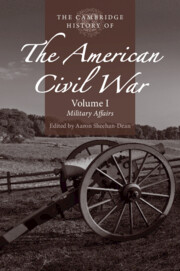Book contents
- The Cambridge History of the American Civil War
- The Cambridge History of the American Civil War
- The Cambridge History of the American Civil War
- Copyright page
- Contents
- Maps
- Contributors to Volume I
- Acknowledgments
- Note on the Text
- 1 Introduction: The Cambridge History of the American Civil War
- Part I Major Battles and Campaigns
- 2 The Battles of Virginia, 1861
- 3 The Battles of Tennessee, 1862
- 4 The Battles of the Trans-Mississippi, 1861–1863
- 5 The Peninsula Campaign
- 6 The Shenandoah Valley Campaigns of 1862 and 1864
- 7 The Second Bull Run Campaign
- 8 The Antietam Campaign
- 9 The Western Theater, 1862–1863
- 10 The Battle of Fredericksburg
- 11 The Chancellorsville Campaign
- 12 The Gettysburg Campaign
- 13 The Vicksburg Campaign
- 14 The Battles of Tennessee, 1863
- 15 The Overland Campaign
- 16 The Georgia Campaign
- 17 The Carolinas Campaign
- 18 The Tennessee Campaign, 1864
- 19 The Petersburg and Appomattox Campaigns
- Part II Places
- Index
- References
8 - The Antietam Campaign
from Part I - Major Battles and Campaigns
Published online by Cambridge University Press: 11 October 2019
- The Cambridge History of the American Civil War
- The Cambridge History of the American Civil War
- The Cambridge History of the American Civil War
- Copyright page
- Contents
- Maps
- Contributors to Volume I
- Acknowledgments
- Note on the Text
- 1 Introduction: The Cambridge History of the American Civil War
- Part I Major Battles and Campaigns
- 2 The Battles of Virginia, 1861
- 3 The Battles of Tennessee, 1862
- 4 The Battles of the Trans-Mississippi, 1861–1863
- 5 The Peninsula Campaign
- 6 The Shenandoah Valley Campaigns of 1862 and 1864
- 7 The Second Bull Run Campaign
- 8 The Antietam Campaign
- 9 The Western Theater, 1862–1863
- 10 The Battle of Fredericksburg
- 11 The Chancellorsville Campaign
- 12 The Gettysburg Campaign
- 13 The Vicksburg Campaign
- 14 The Battles of Tennessee, 1863
- 15 The Overland Campaign
- 16 The Georgia Campaign
- 17 The Carolinas Campaign
- 18 The Tennessee Campaign, 1864
- 19 The Petersburg and Appomattox Campaigns
- Part II Places
- Index
- References
Summary
The victory of the Confederate Army of Northern Virginia at the Battle of Second Manassas on August 30–1, 1862 left its commander, Robert E. Lee, with three strategic options. He could besiege the Union capital, Washington, D.C.; he could withdraw to Warrenton, Virginia, where his exhausted and poorly supplied army could resupply and recover; or he could carry forward his summer offensive by crossing the Potomac and invading Maryland, and, if circumstances allowed, Pennsylvania. Lee dismissed the first out of hand. His army had neither the logistics nor strength to attempt a siege. The second surrendered the initiative to the enemy and permitted the Federals to reorganize and train the many new regiments raised in response to President Lincoln’s call for 300,000 new volunteers in July 1862. Lee believed the third option offered the greatest opportunities and it kept the initiative in his hands, something he always sought. He related to Confederate president Jefferson Davis that his army was not “properly equipped for an invasion of an enemy’s territory,” but from both a political and military perspective there was sound logic to invasion. The Union Army of the Potomac and Army of Virginia were disorganized and demoralized. Invading Maryland would force the Federals to place an army in the field before they had reorganized. Lee believed it would also force the Federals to withdraw their garrisons at Martinsburg and Harpers Ferry, Virginia, clearing the Shenandoah Valley of all Union troops. Politics figured importantly in Lee’s strategic thinking. He held out little hope for European recognition of the Confederacy. The key to victory was Northern morale and will. In Lee’s view, eroding it with Confederate battlefield successes offered the best prospect for a negotiated peace. Victories on Southern soil were helpful but victory on Northern soil carried the prospect of being politically decisive. Given the condition of the army, invasion was a gamble, but a carefully calculated one on Lee’s part.
- Type
- Chapter
- Information
- The Cambridge History of the American Civil War , pp. 141 - 164Publisher: Cambridge University PressPrint publication year: 2019



